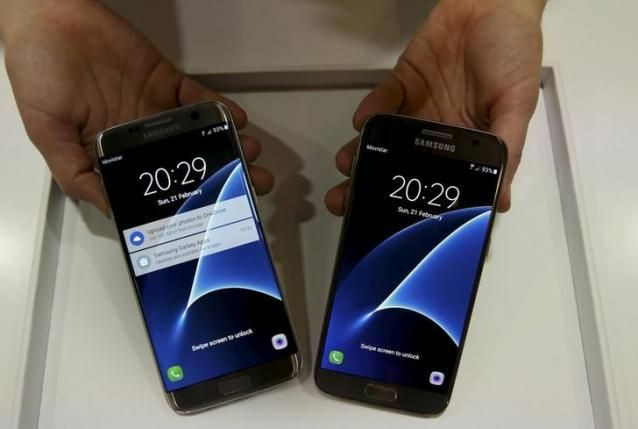Samsung Galaxy S7, S7 Edge, HTC 10, LG G5 Or None Of The Above? Specs For All Android Flagship Phones

This April it's showering Android smartphones as HTC and LG both released new flagship phones to compete with the Samsung Galaxy S7 and Galaxy S7 Edge, which came out in March. Android smartphones used to be more about inner beauty than sleek design, but a lot has changed over the last few years. For consumers looking to upgrade or make the switch from Apple's iPhone, now's the perfect time to take a look at Android.
Samsung Galaxy S7, Samsung Galaxy S7 Edge ($694.99, $779.99) - The Best Smartphone, Android or Otherwise, Out There?
The Samsung Galaxy is what we talk about when we talk about flagship Android smartphones. The Galaxy S7 — and the curved-screen S7 Edge — are already off to a strong start since being released March 11. In fact, strong initial sales of the S7 may be behind a 10.4 percent increase in operating profit for the first three months of 2016, which could signal a gradual recovery of Samsung's smartphone business from a two-year slump, according to the Wall Street Journal.
For some reviewers, the Galaxy S7 and S7 Edge are the best phones currently available. At the very least, the S7s are the best smartphones Samsung has ever produced with the distinction of being the Android smartphone to beat. Some critics give the Samsung Galaxy S7 Edge a slight advantage over the S7 for its larger screen and battery, but either smartphone would make for a worthy upgrade for consumers.
The Galaxy S7, with a 5.1-inch display, and Galaxy S7 Edge, with a 5.5-inch display, are water-resistant for up to 30 minutes in up to 5 feet of water. Both devices feature a rear 12-megapixel camera with a 5-megapixel front camera that may be the best on the market, according to Cnet. Other features include fast wireless charging, Samsung Pay support, Android Marshmallow OS and expandable memory up to 200GB with a microSD card. The lack of replaceable battery and a tendency to attract fingerprints are among the main drawbacks for the Galaxy S7 and Galaxy S7 Edge. If you're looking for a large-but-not-colossal smartphone, the Galaxy S7 may be the better option. The S7 Edge does have a more narrow profile than other 5.5-inch devices, which may make it an easier sell for users who want to put the phone in their pocket.
HTC 10 ($699) - For the Audiophile
HTC may not have the same recognition as Samsung, but the Taiwan manufacturer has garnered its share of devotees with its slick metal design and the great displays found in its flagship phones, the HTC One and last year's HTC One M9. Unfortunately, the Android marketplace has caught up with HTC in the design department, which leaves the HTC 10 an undistinguished, but solid, phone.
The HTC 10 is the best phone HTC has produced, but it's suffering some fatigue as the company continues to follow design choices from several generations ago, according to the Verge. The audio output is a highlight for the HTC 10 and could be the feature that sells the phone for anyone who uses their headphones all the time. While the HTC 10 eliminates the beloved front-facing stereo speakers, the smartphone still has a great audio setup, according to Engadget. For headphones, the HTC 10 creates an audio profile that users can customize for the optimal listening experience.
The HTC 10's camera is a big upgrade from the HTC M9. The 5.2-inch, quad HD display is pretty standard for flagship Android phones, but HTC's glass design creates a seamless integration between the glass and aluminum unibody. Overall, the HTC 10 is a well-designed phone that may fall just short of the Samsung duo, but may be a perfect choice for those who want the most out of their headphones.
LG G5 ($688.99) - Totally Modular
The LG G5 is a breath of fresh air that may suffer from being the first to the market. The modular design is a great concept. Having a phone with optional parts that can be swapped out based on consumer preference would add longevity and value to any smartphone on the market. Shutterbugs can snap in an optional module to boost a camera's capabilities. The same principle could apply to audio options or power users looking for the best battery life available.
Unfortunately, it's better in theory than in practice, according to the reviewers. There aren't enough modules currently available to sell the device, notes Cnet. Currently, there's the Cam Plus that adds a shutter button and zoom wheel. The Hi-Fi Plus converts digital to audio for improved sound. The LG G5 turns off when swapping parts, which could drain the battery throughout the day.
Modular disappointment aside, the LG G5 boosts the only removable battery of the flagship phones. The two rear cameras were also impressive.
The Flagship Yet to Be Released
The Galaxy S7, Galaxy S7 Edge or HTC 10 are all worthy contenders for consumers looking for a great Android smartphone. There's also the Nexus 6p and 5X, released in 2015, from Google, which are quality options at a lower price. Huawei just announced its P9 and P9 Plus flagship phones earlier in April, while Sony's Xperia X lineup will be released over the summer. Even if you're on the fence about what to purchase, 2016 is a great year to be in the market for an Android handset.
© Copyright IBTimes 2024. All rights reserved.






















